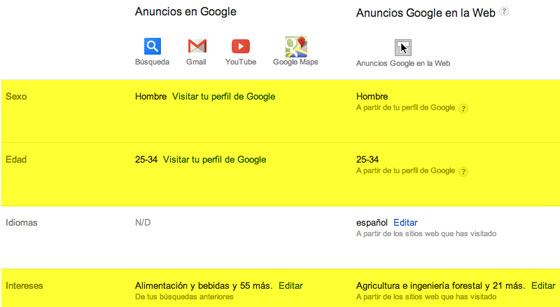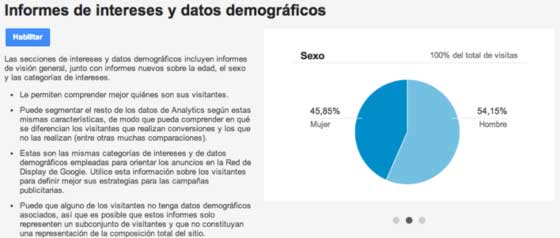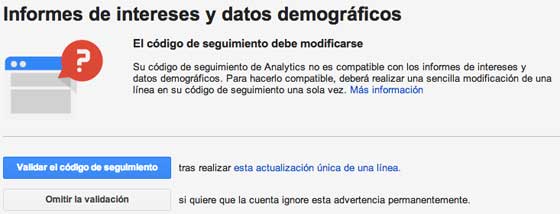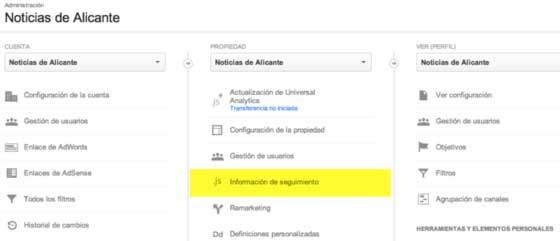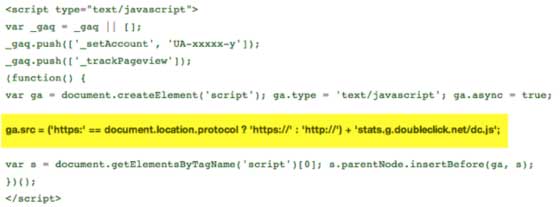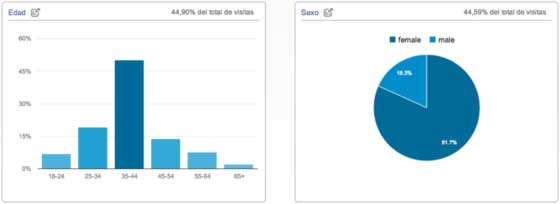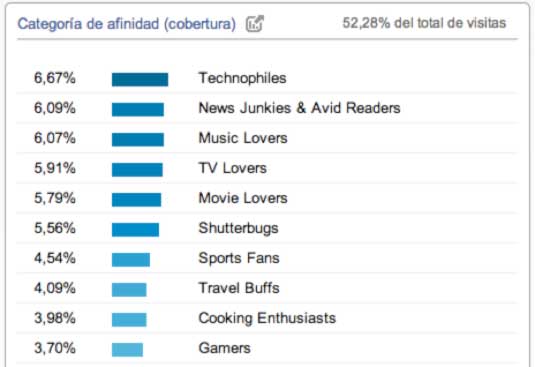Written by Jose Vicente
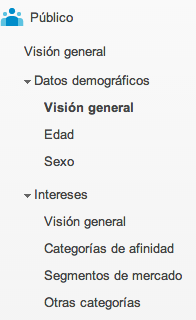
Demographic data provides us with information about the age and gender of users who visit our site. The interests section , on the other hand, offers us data such as affinity categories by which users who visit our site usually search for information or market segments by which our users are more interested in buying products or contracting services.
The purpose of these two new sections is to better understand who is visiting our site. Please note that we will only obtain data from users who have filled in the Google Ads Settings. According to Google’s documentation it is possible that data may not be obtained from some users, but in our tests we only obtained data from about half of the users. A 50% sample in many cases is an important enough percentage to draw conclusions or segment data to better define the profile of users who convert the most on our site. Remember that in analytics we handle patterns and trends in metrics and not specific figures.
Before activating this functionality, there are a couple of things to consider:
- At the moment this functionality is not available for Universal Analytics accounts. Therefore, if we enable interest and demographic reporting and upgrade our account to Universal Analytics, we will stop recording data until Google supports it.
- We must include the
Display Advertising clauses
in our privacy policy.
Activation
When we access for the first time to any of these two sections we can see a description of them with example graphics and an Enable button.
When you click on enable interest and demographic data reports, the following screen appears.
In order for our tracking code to be compatible we must make it get the data from Google’s advertising network. If we access our account management and specifically the property tracking information where we want to activate the interest and demographic data reports,
We will probably find the “Show advertiser support” option unchecked. We proceed to activate it and we will see how the tracking code suggested by Google changes one of the lines.
This change causes data to be obtained from the DoubleClick cookie instead of the standard Analytics cookie.
This change is compatible with both synchronous and asynchronous version of the tracking code and does not affect any modifications we have made to the Analytics tracking code. As mentioned before, it will not work for the moment if we have a Universal Analytics account.
Once the tracking code has been changed we can click on the “Validate tracking code” button. On some occasions we have found that this step gives an error despite having correctly configured the code and that by clicking on the “Skip validation” button the section begins to record data.
Demographic data
This section is the simpler of the two, it provides data on age and gender of users accessing our site. In the following screenshot we can see an example of a site where the majority of users are women between 35 and 44 years old.
In this case, the sample does not reach 45% of the users accessing our site.
Interests
As its name indicates, this section shows the interests of our users. To obtain this information, Analytics offers us 3 new data dimensions:
- Affinity categories: these are categories for which our users are most interested in obtaining information. Therefore, increasing the amount of content about these categories on our site would keep these users coming back for more information about these topics and increase the number of page views. On sites whose monetization is based on banner impressions, it can be interesting to increase the amount of interesting information for users and thus increase the number of page views or page impressions.
- Market segments: these are the segments where users are most likely to buy products or services. This can reveal new market niches by offering products or services of this type on our website. If for example we have a website where we offer hotel reservations and we see that most of our users are interested in buying and renting properties, we could offer a new service of apartment rentals or packages of stay plus visits to real estate properties + From this metric we usually have a lower percentage of data since the percentage of users who make purchases is lower compared to those who search for information on the Internet.
- Other categories: define categories for which our users usually search for information and are also predisposed to buy products or services.
- Affinity categories: these are categories for which our users are most interested in obtaining information. Therefore, increasing the amount of content about these categories on our site would keep these users coming back for more information about these topics and increase the number of page views. On sites whose monetization is based on banner impressions, it can be interesting to increase the amount of interesting information for users and thus increase the number of page views or page impressions.
What are interest and demographic reports useful for?
Once these reports have been activated, when we know what new data dimensions we can obtain from each of them, we must understand the value that these new Analytics sections bring us. Depending on the type of our site, we can perform different analyses and actions to improve its performance:
- Obtain more information on the traffic segments that convert the most on our site: thanks to other functionalities such as Analytics goals or e-commerce, we can find out which users convert the most on our site. Now we have more data about them, what content they are most interested in and with this we know what added value we can offer them so that they return to convert on our site.
- Discover new potential customers: in the same way that we can find out which users convert, we can find out which ones do not. Knowing who they are and what they are interested in gives us a lot of information to try to understand why they have not converted on our site and what we can offer them to do so.
- Improve remarketing lists: by better understanding the interests of our target audience we can create better remarketing lists to better target Display Network ads and thus achieve better conversion.
With these new sections of Analytics, Google goes a step further to provide us with more detailed information about the users who visit our site. This will allow us to offer them the information they are most interested in – thus improving their user experience – and get them to convert more on our site.
